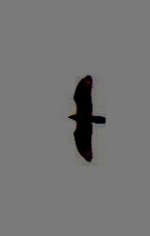KenM
Well-known member
Excellent photos, Tom. They show that typical buteo buteo jizz, which is seen also on Ken's photos.
The actual lenght of the tail is VERY hard to estimate. Due to the different look it gives in different flight modes and at different angels.
Remember vividly how I once tentatively identified a distant, approaching, migrant falcon in poor light (seemed all dark) as a Hobby due to its flight and general jizz.
Another "heavy dude" birder beside me claimed that it was a male Red-footed Falcon. When the bird was almost over our heads (close!) the light conditions changed, so that we could see that it was indeed an adult Hobby.
The other birder then indignantly exclaimed:
that's the most long-tailed Hobby I've ever seen!
Had this bird, at that very moment, suffered a fatal heart attack, and had fallen to the ground for measurements to be taken, my instincts suggested that I could have gone and bet the farm that the tail lenght didn't differ from the average......
Peter
We have accord in the first statement.
To determine body to tail length....slap a ruler on it!
I don't use anecdotal "evidence" when attempting to qualify an ID, I try and deal with the subject matter (images...as are presented before me, as I wouldn't want to appear disingenuous).
cheers





